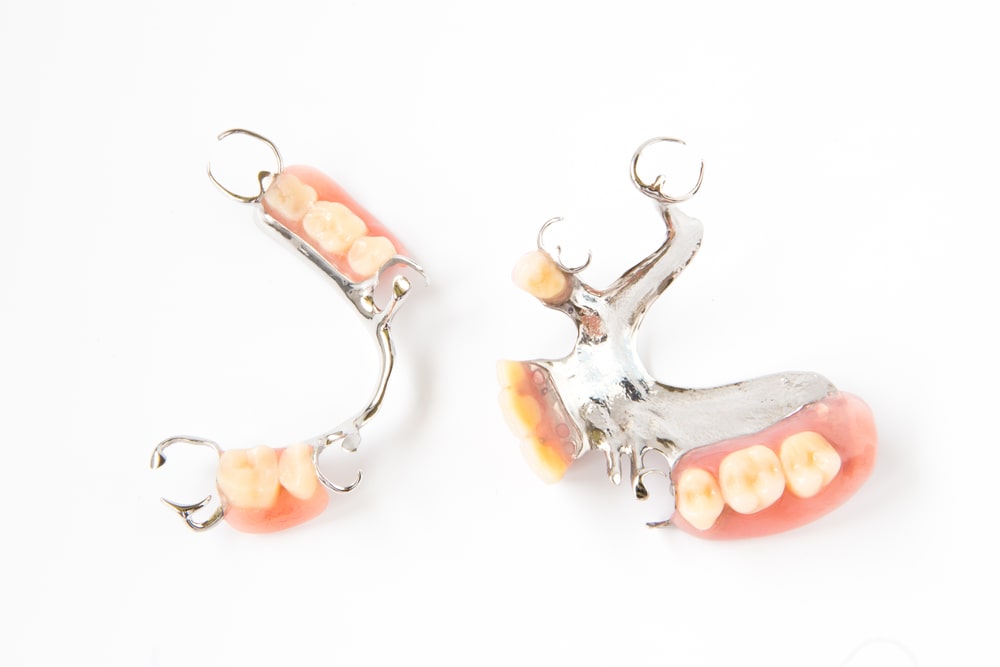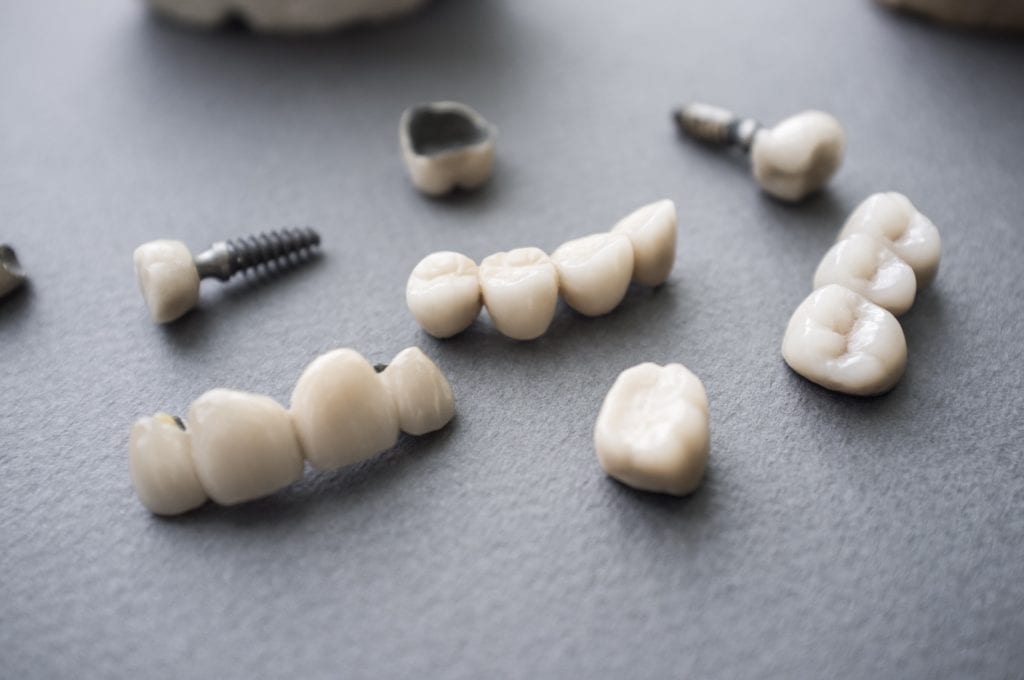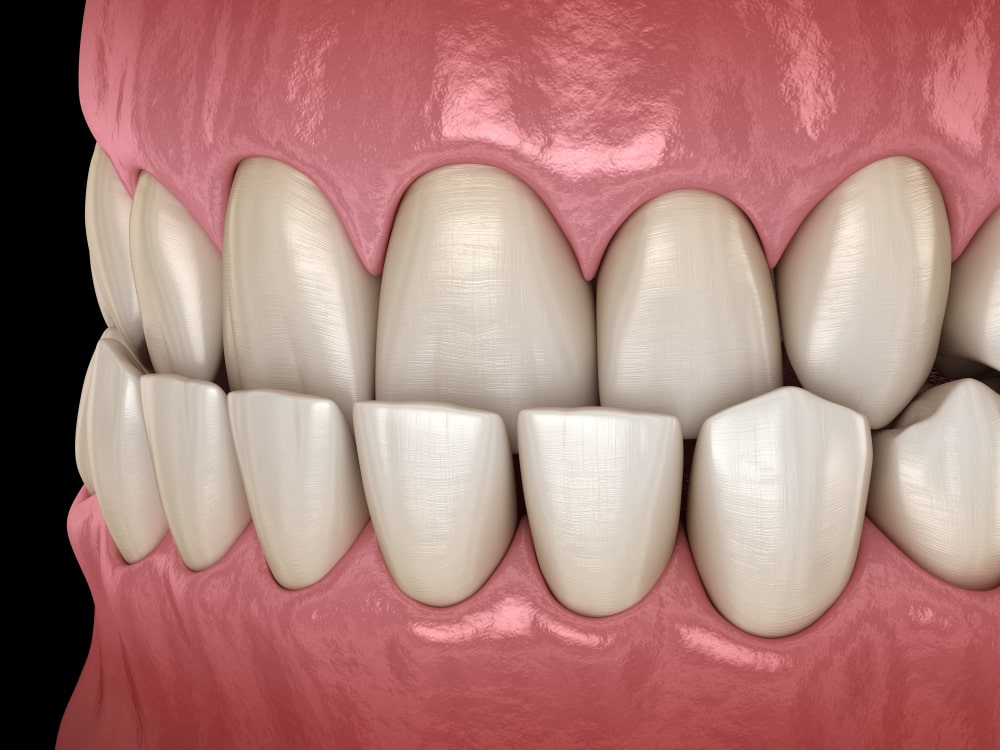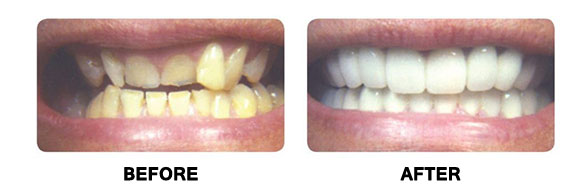There is no pain like tooth pain. It is persistent and distracting. It can keep you from sleeping and the pain can even put you in danger. However, even though toothaches are so painful, sometimes people put off going to the dentist. They are convinced a trip to the dentist is going to mean painful and expensive dental work.
That is not always true. Sometimes the fix for a toothache may be as easy as a thorough cleaning or getting a nightguard to prevent you from grinding your teeth in your sleep. In fact, the solutions to toothaches are as numerous as the causes of toothaches.
There are four major types of toothaches. Many people will experience temperature sensitivity. Your teeth feel fine, but something too hot or too cold will make you wince. Other times, you have a dull ache in your mouth that seems to never go away. If left alone, the dull ache gets worse over time. Some people may feel fine and then get sharp, stabbing pains that come and go. Finally, there is a severe, throbbing pain. While all dental pain is inconvenient, the severe, throbbing pain requires immediate dental care as it could indicate a serious infection.
The most common cause of tooth pain is probably sensitive teeth. Many of us eat acidic foods that wear away tooth enamel, making us sensitive to hot and cold. Your dentist can inspect your mouth to ensure you do not have any cracked teeth, gum disease or other issues. They may apply sealants. They will probably instruct you to switch to an enamel-building toothpaste for sensitive teeth.
If you still have your wisdom teeth, they could be impacted and cause pain. This is common in people in their early adult years, who did not have their wisdom teeth removed as teenagers. Not all people need wisdom teeth removed- it depends on the size of your mouth.
Gum disease is a potential cause of tooth pain. However, if you get regular dental checkups, your dentist will probably be able to identify gum disease in its earlier stages (gingivitis) and before it progresses to the point of causing pain.
Of course, tooth decay or damage to the tooth’s structure can cause toothaches. When you have a cavity or tooth decay, the surface of your teeth gets destroyed, which can expose the root. That can lead to pain. Regular cleanings, exams, and x-rays are designed to detect cavities before they can become painful. They also help your dentist use less invasive treatments, such as fillings, to treat the cavity.
Finally, abscesses, which are infections inside the tooth, can cause serious pain. They are also a medical emergency. These infections are notoriously painful, can cause high fevers, and can lead to bone loss. The treatment for an abscess is usually a root canal. However, root canals have a bad reputation as a painful treatment. Root canals themselves are awkward and can be uncomfortable, but should not be painful. The dentist thoroughly numbs the area. Plus, while you will leave the office feeling a little sore, in most cases root canals provide immediate relief from the severe pain you were experiencing.
As you can see, several things can cause toothaches. Some of the solutions are non-invasive and others may just take a quick fix. So, the best thing to do is to get to the dentist as quickly as possible. With a dental exam, your dentist should be able to choose the best path to resolve the problem. Call us today to schedule an appointment at 732-556-9600.

Dr. Anthony Mancino is Monmouth and Ocean County New Jersey’s General and Cosmetic Dentist and has been practicing for over 25 years focusing on cosmetic and overall dental health. Dr. Mancino is a graduate of Villanova University and University of Pennsylvania. He is also a member of the American Dental Association, New Jersey Dental Association, Monmouth & Ocean County Dental Association, American Academy of Cosmetic Dentistry, and the Academy of General Dentistry.
Everyone knows that you should brush your teeth at least two times per day. Once, at night before you go to bed. The other time in the morning when you wake up. There is even a silly saying about it, that you brush at night to save your teeth and in the morning to save your relationships. However, your morning brushing does more than conquer morning breath. It is also important for the health of your teeth.
In many ways, whether you brush before or after breakfast is a matter of personal preference. However, because breakfast foods may be acidic, brushing at the wrong time can actually weaken tooth enamel. So, whether you brush before or after you eat breakfast, you do not want to brush within 30 minutes of eating.
If you brush before breakfast, you get that morning breath out of your mouth. Morning breath does not just smell gross; it can also impact the taste of your food. While morning breath is embarrassing, it is normal. As you sleep, bacteria in your mouth multiply. These bacteria are responsible for causing morning breath, but, even worse, they cause plaque. When you brush your teeth with a fluoride toothpaste, you get rid of those bacteria. Modern toothpastes also coat your teeth with a protective barrier that can help keep acid in your food from damaging your teeth. In addition, brushing first thing helps promote saliva. Saliva is your body’s way of protecting your teeth. So, brushing first thing can be great.
Another reason that many dentists advise brushing before breakfast is because many breakfast foods are sugary. The same bacteria that cause morning breath love to feast on sugars. So, if you have a carbohydrate-heavy breakfast, they are ready to feast on those sugars, which can promote tooth decay. Brushing the bacteria out of your mouth stops that process. However, if you are having a sugary breakfast, you also run the risk of sugar sitting in your mouth all day.
The big pro to brushing after breakfast is fluoride. If you brush after breakfast and do not take a drink to-go, the fluoride sits on your teeth, uninterrupted. That can give you better protection throughout the day. So, if you do decide to brush after you eat, you can still protect your teeth. Just wait about an hour after eating to brush your teeth. You can also chew sugar-free gum just after brushing to help boost saliva-production, which will help you counteract any acid that is lingering in your mouth.
The smaller pro to brushing after breakfast is your breath is going to smell better. Eating a meal disrupts that minty-fresh smell of your breath. If you are not going to consume anything else, leaving the house with a freshly brushed smile will make your day more pleasant for you and everyone you encounter. However, that is not reality for many people. Many of us are leaving the house with a coffee or other beverage in a to-go cup. They can make our breath smell, too.
So, the general consensus is that it is better to brush before breakfast. However, dentists also think it is more important to brush after breakfast than to skip your morning brushing. So, if you are more likely to brush if you wait till after breakfast, then keep it as part of your routine. The most important thing is to consistently brush for 2 minutes or longer every morning and night. Developing those habits is one of the best ways to keep your mouth healthy.

Dr. Anthony Mancino is Monmouth and Ocean County New Jersey’s General and Cosmetic Dentist and has been practicing for over 25 years focusing on cosmetic and overall dental health. Dr. Mancino is a graduate of Villanova University and University of Pennsylvania. He is also a member of the American Dental Association, New Jersey Dental Association, Monmouth & Ocean County Dental Association, American Academy of Cosmetic Dentistry, and the Academy of General Dentistry.
You go to the dentist to keep your teeth healthy. Generally, better oral health means a nicer looking smile. However, for millions of people, visiting a regular dentist is not enough to give them the smile they want. Your general dentist focuses on preventing tooth decay and other dental problems. However, a cosmetic dentist performs cosmetic procedures that can give you a brighter, prettier smile. Figuring out what you want from your dentist can help you determine the type of dentist to visit.
First, you should be seeing a general dentist at least twice a year. General guidelines are that people get cleanings every six months and x-rays once a year. X-rays help your dentist spot problems before they can develop into something serious. They can help save your teeth and prevent further tooth decay. So, if you are not seeing a dentist now, you want to make sure you are seeing a dentist at least twice a year.
A general dentist is like the general practitioner for your mouth. They focus on oral hygiene, fixing cavities, and addressing tooth pain. General dentists handle procedures like cleanings, fillings, and root canals. Although, in some cases your general dentist may refer you to an endodontist, which is another type of specialized dentist.
Cosmetic dentists have the same training as a general dentist, but they focus on making your smile look more attractive, as well. Most cosmetic dentists perform teeth cleanings, x-rays, fillings, and other standard dental work. However, some cosmetic dentists may prefer to focus on the cosmetic aspect and work with a general dentist for basic care. Those details depend on the dentist. For example, some practices focus on providing a single aspect of cosmetic dentistry, like veneers or caps.
A cosmetic dentist focuses on how your smile looks. They are focused on aesthetics. So, they offer things like veneers, implants, tooth whitening, and other procedures. These procedures might be considered restorative if they help return teeth to a prior condition, or purely cosmetic. The difference can be important when looking at insurance coverage.
Both type of dentists can also handle braces. Years ago, dentists did not handle orthodontics. Instead, they sent you to an orthodontist if you needed braces or other work. However, today many dentists also handle orthodontics, especially with non-invasive tooth straightening techniques. So, both a cosmetic dentist and a general dentist may be able to help you get a straighter smile. That is no surprise. While straightening your teeth may seem cosmetic, it can actually have a positive impact on your health. So, insurance may cover some portion of orthodontic care.
So, which type of dentists should you see? To decide, you need to determine your tooth goals. That can depend on what is going on in your mouth. If you need root canals, crowns, or dental implants after having a tooth removed, then you are in a different position than someone who just wants tooth whitening.
One of the best ways to start is to schedule a consultation. When you visit your dentist, they should have a treatment plan to outline the care for your teeth. The treatment plan is based on the condition of your teeth. If you have additional cosmetic concerns, you should discuss them with your doctor to add them to your treatment plan.

Dr. Anthony Mancino is Monmouth and Ocean County New Jersey’s General and Cosmetic Dentist and has been practicing for over 25 years focusing on cosmetic and overall dental health. Dr. Mancino is a graduate of Villanova University and University of Pennsylvania. He is also a member of the American Dental Association, New Jersey Dental Association, Monmouth & Ocean County Dental Association, American Academy of Cosmetic Dentistry, and the Academy of General Dentistry.
Teeth can fall out for any number of reasons including damage, decay, gum disease, or trauma. With the exception of your third molars, also known as wisdom teeth, every tooth in your mouth is necessary for proper function. Therefore, when a tooth is lost, your dentist will recommend that you replace the missing tooth as soon as possible.
When it comes to replacing missing teeth, many people are hesitant because of the cost. However, what some people may not realize is that there are a variety of options for replacing missing teeth. These options can offer different treatment methods and can fit different budgets.
Ultimately, the cost of replacing a missing tooth will depend upon the restoration method, as well as the dental materials used. Let’s take a look at some common restoration treatments for missing teeth to give you a better idea about cost.

A dental bridge uses a dental crown mounted on the teeth surrounding the gap to support a fake tooth, or pontic. Sometimes, more than one pontic may be used if multiple adjacent teeth are missing. The cost of a dental bridge will increase if more than one pontic is required. Additionally, the cost of a dental bridge is also dependent upon the materials used to fabricate the crowns and pontics or if the dental bridge needs to be replaced. Certain dental materials cost more than others, however they also have other pros and cons that must be considered.

Dentures are generally used to replace multiple missing teeth. Partial dentures are used in cases where there are still intact teeth, while full dentures are used when there are no remaining teeth. Partial dentures are usually more affordable than full dentures, however there must be enough teeth to support them. The dental materials used to fabricate dentures will also play a role here as well. With dentures, the fake teeth will need to be fabricated, as well as the framework. Although it can vary, generally speaking metal framework tends to be more affordable than an acrylic framework that looks like real gum tissue. Once again, you will need to consider the pros and cons of each dental material available to you. For more information, see our article on “What are Dentures Made Of?”

Dental implants are artificial tooth roots that are implanted into the jaw bone and used to support a dental prosthesis. To replace a single missing tooth, an implant-supported crown is used. To replace multiple missing teeth either an implant-supported bridge or implant-supported denture is used, depending on how many teeth are missing. With dental implants, there is the cost of the implant as well as the prosthetic that is attached to it.
In addition to the type of method used to replace missing teeth, another thing you need to consider is how long the treatment is expected to last, as well as the cost of potential maintenance. Some methods may have a lower upfront cost, but you’ll end up paying more in maintenance, while others have a higher upfront cost, but only require little to no maintenance. These are things you should discuss with your dentist prior to making a decision.
As you can see, the cost of replacing missing teeth is somewhat ambiguous and varies depending on a number of factors. You will need to consider your treatment method, the dental materials used, and its lifespan to determine the actual cost. Although there are several sites that offer estimates, they are just that: estimates. To find out for sure how much it costs to replace missing teeth, schedule a consultation with your local dental office. Most dental offices will offer free or discounted consultations that allow you to learn more about your options.

Dr. Anthony Mancino is Monmouth and Ocean County New Jersey’s General and Cosmetic Dentist and has been practicing for over 25 years focusing on cosmetic and overall dental health. Dr. Mancino is a graduate of Villanova University and University of Pennsylvania. He is also a member of the American Dental Association, New Jersey Dental Association, Monmouth & Ocean County Dental Association, American Academy of Cosmetic Dentistry, and the Academy of General Dentistry.
Dentures are a type of dental prosthetic that is used to restore an entire arch of teeth or both arches to restore an entire mouth of missing teeth. They are designed as artificial teeth and gums that sit on top of the natural gum tissue. Dentures can be worn throughout the day to help with functions like eating and speaking, however they are removed at night.
When a dentist recommends dentures, patients often wonder what dentures are made of and how they are made. After all, many want to be sure that their dentures will be visually appealing and made out of safe dental materials. Luckily, your dentist has your best interests in mind and will use special dental materials that are safe, effective, and aesthetic.

Dentures contain two main parts that require different dental materials. Namely, these are the false teeth and the framework. Denture teeth are fabricated using either resin or porcelain. Resin can be colored to resemble natural teeth and is a more affordable dental material. Porcelain is considered to be highly aesthetic in terms of its color and texture, but it can also be a more expensive dental material to make dentures from. Additionally, porcelain is usually only recommended for full dentures, meaning most partial dentures teeth are made from resin. This is because porcelain is highly abrasive to tooth enamel and can cause damage or premature wear in the opposing teeth.
The composition of denture framework can vary depending on the type of denture. Full dentures will be fabricated to look like natural gums and will be made with an acrylic or nylon base, and acrylic gum attachments. In some cases, full dentures may also use metal gum attachments, but these are usually not noticeable when the denture is in place. Partial dentures use the same acrylic or nylon base, however they may also contain metal clasps that wrap around surrounding teeth and hold the denture in place.
Now that we know what dentures are made of, let’s take a look at the way dentures are made. The first step to having dentures made is to have your dentist take a dental impression. A dental impression uses a metal tray filled with impression putty that is designed to change from a smoothie consistency to a rubber consistency in as little as a minute. This allows your dentist to obtain a mold of your mouth that they can send to a dental lab to have your dentures fabricated.

To make your denture, a special device called an articulator will be used to replicate the jaw. The mold of your upper and lower arch will be attached to the articulator to create a functional model of your mouth so the dentures can be fabricated for function and appearance. In the early stages, fake teeth will be attached to a wax framework to make a test model. This model will be checked for fit and adjustments will be made if needed.
Once the wax model has been fitted, it will be used to make the permanent restoration. This is accomplished by pouring hot plaster into the wax framework. This melts the wax and allows the plaster to take its shape. A solution to prevent sticking is applied to the plaster before the acrylic or nylon is poured into the plaster. After everything has hardened, the final step is to remove the plaster, revealing a completed dentures. The final product will then be polished and sent to your local dental office.
As you can see, dentures are made from certain dental materials that are effective and aesthetic. The fake teeth used for dentures are made from resin or porcelain, while the framework is made with acrylic or nylon. Additionally, the fabrication process for a denture shows how every little detail of your smile is taken into account when making your dentures.

Dr. Anthony Mancino is Monmouth and Ocean County New Jersey’s General and Cosmetic Dentist and has been practicing for over 25 years focusing on cosmetic and overall dental health. Dr. Mancino is a graduate of Villanova University and University of Pennsylvania. He is also a member of the American Dental Association, New Jersey Dental Association, Monmouth & Ocean County Dental Association, American Academy of Cosmetic Dentistry, and the Academy of General Dentistry.
It’s a new year and a new year means a new you, so why not a new smile? If one of your resolutions was to be happier, then smiling regularly is a key part of achieving that goal. However, smiling all the time is much easier when you feel good about the smile you are showing the world. One way to quickly brighten up the appearance of your smile is to have your teeth professionally whitened.
Professional teeth whitening is a cosmetic dental procedure performed in a dental office. Unlike over the counter whitening treatments, in-office treatments use a higher concentration of whitener and are applied by a dental professional. This means there are fewer risks and better results than over the counter treatments.
When considering whitening treatments, a common question you may want to ask your dentist is, “how long does teeth whitening last?” It has been found that whitening treatments can last anywhere from 6 months to 3 years, with the average being around 1 year. In most cases, there are different factors that can affect how long your whitening results last. These can include initial color, type of stain, the rate of exposure to highly pigmented materials, and oral habits.
Stains can be derived from a variety of sources, but the most common come from pigments in the food and beverages we consume. Some examples of stain culprits are:

These highly pigmented materials contain chromogens, which are colored molecules. Since your teeth are porous, they absorb these colored molecules and become discolored over time. The more you eat or drink things with colored molecules, the faster your teeth will become discolored. This is one reason why teeth whitening results can vary based on the individual. Therefore, people who regularly consume pigmented foods and beverages are more likely to have their results fade around the six month mark, while those who do not may be able to extend their results for longer.

However, stains can also be caused by other factors that cannot be easily managed, such as age, genetics, and certain medications. You cannot control your age or your genetics, and taking certain medications is most likely necessary to maintain your overall health. Nevertheless, these factors can also play an integral role in how long your whitening results last. Because of this, they should be discussed with your cosmetic dentist prior to having your teeth whitened.
Luckily, there are also things that can extend your whitening results. Maintaining great oral hygiene is one main way to keep your teeth whiter for longer. Twice daily brushing and flossing once a day removes the excess plaque and tartar, as well as superficial stains before they can be absorbed into the tooth. Brushing after consuming highly pigmented substances can also help keep discolorations under control. In some cases, your cosmetic dentist may also provide you with take home whitening trays or special whitening toothpaste to maintain your results.

Dr. Anthony Mancino is Monmouth and Ocean County New Jersey’s General and Cosmetic Dentist and has been practicing for over 25 years focusing on cosmetic and overall dental health. Dr. Mancino is a graduate of Villanova University and University of Pennsylvania. He is also a member of the American Dental Association, New Jersey Dental Association, Monmouth & Ocean County Dental Association, American Academy of Cosmetic Dentistry, and the Academy of General Dentistry.

Many dentists are familiar with patients who have dental anxiety and are more than willing to help you manage that anxiety. However, they don’t know that you are feeling anxious about something if you don’t tell them. Discussing your dental anxieties and fears with your dentist before they start anything can be empowering and make you feel a sense of control. With severe cases of dental anxiety, you may want to schedule an appointment just to discuss these concerns and then return at a later date for the actual dental appointment at the office.
Part of feeling comfortable in the dentist’s office and chair is to feel comfortable with the dentist. In most cases, bad dental experiences are not a result of dentistry itself, but the dentist. Having the wrong dentist can cause you to associate the dentist’s office with negative or unpleasant experiences, which further increases your dental anxiety. Taking time to choose the right dentist is a very important step to managing dental anxiety.

Certain relaxation techniques like deep breathing, acupressure, and meditation can work well to help you decrease your anxiety levels. However, the key to using relaxation techniques effectively is to practice them several times before you are in an anxious state. This is because relaxation techniques work best when your body has been trained to respond to them. Another way you can relax in the dentist’s chair is to listen to music, an audiobook, or a podcast. Instead of focusing on your anxiety, you can focus on what you are listening to. This also works well to drown out any anxiety-inducing noises.
If you know you have a dentist appointment later in the day, skip that morning cup of coffee. Caffeine is a stimulant, which will serve as fuel for your anxiety and will make it worse. You should also avoid sugary foods as well. Instead, focus on eating high protein foods because they naturally produce a calming effect on the body.
If the above strategies do not seem to be working for you, or if you have extreme dental anxiety, then dental sedation may be an ideal option for you. There are varying levels of dental sedation that can be used to relax you, put you in a light sleep, and render you completely unconscious. One common dental sedation method used for dental anxiety is nitrous oxide because it is an inhaled gas that calms you down without lasting effects after the procedure.
While dental anxiety can make it a challenge to visit the dentist’s office, strategies such as talking with your dentist, making sure you have the right dentist, distraction through relaxation techniques or music, avoiding caffeine, and dental sedation can help you feel more comfortable at the dental office. Some of these strategies may require practice or planning ahead, but they can be worth it if they alleviate your stress.

Dr. Anthony Mancino is Monmouth and Ocean County New Jersey’s General and Cosmetic Dentist and has been practicing for over 25 years focusing on cosmetic and overall dental health. Dr. Mancino is a graduate of Villanova University and University of Pennsylvania. He is also a member of the American Dental Association, New Jersey Dental Association, Monmouth & Ocean County Dental Association, American Academy of Cosmetic Dentistry, and the Academy of General Dentistry.
The way they do this is through using cosmetic dental procedures to restore the function of your teeth, while also improving their visual appearance. Depending on your cosmetic concerns and treatment goals, there are several different cosmetic dental treatments to choose from. Although, certain cosmetic procedures tend to be more commonly performed than others. Here are five popular treatments recommended by your cosmetic dentist:


If your teeth are severely damaged, decayed, or missing then your cosmetic dentist may recommend the use of a dental crown or bridge. Dental crowns are caps that fit over the top of your tooth in order to restore the look and function while also protecting the remaining tooth structure. Dental bridges are composed of multiple crowns, as well as a fake tooth and are used to fill in the gaps left by missing teeth.

If you are looking for a way to address multiple cosmetic issues in a single dental treatment and have all of your natural teeth, then your cosmetic dentist may recommend dental veneers. Veneers are thin shells made from porcelain or composite that are bonded to the front side of visible teeth. By having veneers placed, you can easily correct damaged, crooked, unevenly spaced, irregularly shaped, and discolored teeth.

If you have a single missing tooth or multiple missing teeth, your cosmetic dentist may recommend dental implants. Dental implants are placed in the jawbone and act as artificial tooth roots. For a single missing tooth, a dental crown will be placed over the implant, while multiple missing teeth may require the placement of an implant-supported bridge or implant-supported denture. Dental bridges are usually supported by about two dental implants, while implant-supported dentures may require a minimum of four.


If you have minor tooth damage, such as a chipped or cracked tooth, or a small gap between two teeth, then your cosmetic dentist may recommend dental bonding. Dental bonding uses composite resin to repair or rebuild the natural tooth structure. Composite resin is also commonly used for composite fillings, as well as dental veneers.

If you are satisfied with everything but the color of your teeth, then your cosmetic dentist may recommend whitening treatment. During professional teeth whitening treatment, your teeth are cleaned and then whitening trays are placed over your teeth. The trays will usually need to remain in place for 30-60 minutes, depending on the whitener and the treatment goals. The whitener will be absorbed by the enamel and dentin layers, where it will remove years of stains.
Overall, your cosmetic dentist may recommend crowns & bridges, veneers, dental implants, dental bonding, or teeth whitening to makeover your smile. In some cases, a mix of these treatments may also be used to obtain the desired results. Ultimately, only a consultation with your local cosmetic dentist can help you to determine which cosmetic dental treatment or treatments will work best for your smile.

Dr. Anthony Mancino is Monmouth and Ocean County New Jersey’s General and Cosmetic Dentist and has been practicing for over 25 years focusing on cosmetic and overall dental health. Dr. Mancino is a graduate of Villanova University and University of Pennsylvania. He is also a member of the American Dental Association, New Jersey Dental Association, Monmouth & Ocean County Dental Association, American Academy of Cosmetic Dentistry, and the Academy of General Dentistry.
With modern dental technology, orthodontic treatment is easier than ever. In the past, the main option for orthodontic treatment was metal brackets joined together with an arch wire. While this method was, and still is, highly effective, many people did not care for the look and feel of metal braces. For those reasons, an alternative solution was developed in the late 90s.
This solution, known as Invisalign, replaced metal brackets and wires with clear aligners. These clear aligners were customized for each patient in order to gradually reposition their teeth. Although the aligners themselves are removable, they must be worn for about 20-22 hours a day to be effective and should only be removed when eating, brushing, or flossing.
Many people seek Invisalign treatment as a way of straightening their teeth to improve the look of their smiles. However, what some may not realize is that Invisalign also has the potential to correct bite issues known as malocclusion. In addition to properly aligning the teeth, Invisalign can also potentially correct these four types of malocclusion:

If the top front teeth extend too far over your bottom front teeth, then it is known as an overbite. Overbites are also sometimes referred to as deep bites. Although most people have a slight overbite, anything over 25% is considered to be abnormal and should be corrected to prevent future dental issues. If not treated, overbites can cause premature tooth wear and jaw pain.
If you notice your upper teeth sitting behind your lower teeth when you close your mouth, then it is known as a crossbite. Crossbites are when both the top and bottom jaws are not aligning properly. Unfortunately, they can cause a range of dental issues such as premature tooth wear, gum recession, bone loss, and damage to the teeth such as chips or cracks. While Invisalign can work on some types of crossbite, it cannot always be used as an effective treatment in some cases.

If the front bottom teeth extend too far beyond the top front teeth, then it is known as an underbite. Underbites are generally caused by a mandible that extends too far forward. People with underbites have their teeth wear down faster, and may also have difficulty properly chewing or speaking due to the position of their lower jaw. While Invisalign treatment can correct underbites, there are some severe cases that may also require surgery.
If you close your mouth and your bottom teeth are not in contact with any of your bottom teeth, then this is known as an open bite. Open bites interrupt natural chewing function and can make it extremely difficult to bite into food. They can generally be corrected using Invisalign treatment to close the bite.
As you can see, Invsialign orthodontic treatment has the potential to correct four different types of malocclusion, including: overbite, underbite, crossbite, and open bite. This allows for the proper alignment of both your teeth and your bite, which will prevent future dental issues while also improving the look of your smile. To learn more and determine if Invisalign is the right treatment for you, schedule a consultation with your local Invisalign dentist.

Dr. Anthony Mancino is Monmouth and Ocean County New Jersey’s General and Cosmetic Dentist and has been practicing for over 25 years focusing on cosmetic and overall dental health. Dr. Mancino is a graduate of Villanova University and University of Pennsylvania. He is also a member of the American Dental Association, New Jersey Dental Association, Monmouth & Ocean County Dental Association, American Academy of Cosmetic Dentistry, and the Academy of General Dentistry.
Did you know that your dentist can provide three different types of dental care? In order to become a general dentist, candidates must undergo rigorous training that is comparable to medical school. They must complete four years of undergrad and another four years of dental school before they can earn the title general dentist. General dentists may have two suffixes, either DMD or DDS, however they are both equal.
Once they have obtained their dental degree, they must pass a national dental exam as well as a state licensing exam. Only after both exams are passed can they legally and safely practice as general dentists. After all this, it is pretty safe to say that your general dentist must really know their stuff. During their dental education, dentists receive training in three specific areas. This allows comprehensive dentists to offer their patients three different types of dentistry, including:


Contrary to popular belief, the vast majority of general dentistry is preventative services. General dentists are committed to preserving their patient’s oral health through regular dental exams and cleanings. Dental exams are intended to identify and treat possible dental issues early on, while dental cleanings aim to remove excess plaque to reduce the risk of developing tooth decay or gum disease. General dentists may also order dental x-rays to assess bone health, check for cavities, and to diagnose impacted wisdom teeth. Additional preventative dental treatments provided by a general dentist include dental sealants and fluoride treatments.

Unfortunately, even with the best preventative dental care things can still go wrong. This is where restorative dentistry comes in. Simply stated, restorative dental services are those that restore the natural appearance and function of the teeth. In most cases, restorative dentistry is directed at removing decayed tissue, filling cavities, and repairing damage to the teeth such as chips and cracks. Certain restorative dental treatments are also able to replace a single or multiple missing teeth. Some common examples of restorative dental treatments provided by a comprehensive dentist include composite fillings, dental crowns and bridges, dental implants, and root canals.


Like restorative dentistry, cosmetic dentistry restores decayed, damaged, or missing teeth. However, the main difference between restorative and cosmetic dentistry is that cosmetic dentistry restores the function while also enhancing the visual aesthetics. Although restorative dentistry restores appearance, it lacks the same attention to detail as cosmetic dentistry. Cosmetic dental services don’t only restore the natural appearance, they can also correct discolorations, alignment, spacing, and the size and shape of the teeth. Some examples of cosmetic dental services provided by a comprehensive dentists are teeth whitening and veneers.
When you visit a comprehensive dentist, you can expect to receive preventative, restorative, and cosmetic dental care all at the same dental practice. While preventative services are the most commonly performed, it is reassuring to know that if you opt for restorative or cosmetic services, you will be able to see the same dentist. Due to their rigorous training and experience, general dentists make your life easier by providing a one-stop-shop for all you and your families dental needs.

Dr. Anthony Mancino is Monmouth and Ocean County New Jersey’s General and Cosmetic Dentist and has been practicing for over 25 years focusing on cosmetic and overall dental health. Dr. Mancino is a graduate of Villanova University and University of Pennsylvania. He is also a member of the American Dental Association, New Jersey Dental Association, Monmouth & Ocean County Dental Association, American Academy of Cosmetic Dentistry, and the Academy of General Dentistry.
After-Hours Emergencies Or Issues
Call 732-556-9600
Our Services
Dental Emergencies
General Dentistry
Cosmetic Dentistry
Restorative Dentistry
Full Mouth Reconstruction
Smile Makeover

3350 Route 138 W
Bldg 2, Ste 127
Wall Township, NJ 07719
(732) 556-9600
 3350 NJ-138 W. Bldg 2, Ste 127, Wall Township, NJ 07719
732-556-9600
Prices Vary
Comprehensive Dentistry -
5 star rating - based on 25+ reviews in Google
3350 NJ-138 W. Bldg 2, Ste 127, Wall Township, NJ 07719
732-556-9600
Prices Vary
Comprehensive Dentistry -
5 star rating - based on 25+ reviews in Google
